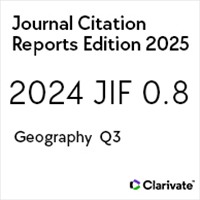Planteamiento introductorio para estudiar la relación entre movilidad prolongada y diáspora: la experiencia haitiana
An introductory approach to study the relationship between protracted mobility and diaspora: the Haitian experience
https://doi.org/10.21670/ref.2409145
Palabras clave:
movilidad prolongada, diáspora, haitianosResumen
Este texto plantea la tesis de que existe una relación cercana entre un proceso de movilidad prolongada y la formación y crecimiento de una experiencia diaspórica haitiana. Este nexo tiene una larga historia, pero toma mayor relevancia a partir del éxodo causado por el terremoto que azotó Haití en enero de 2010, con una dispersión de su población que continúa actualmente a lo largo del continente americano. La base empírica para esbozar este planteamiento proviene de entrevistas realizadas con sujetos haitianos en Tapachula, Chiapas. Los resultados contribuyen a trazar un andamiaje que permita continuar estudiando la movilidad prolongada, incluidos sus momentos de inmovilidad (es decir, pausas, demoras, esperas, etcétera), vis a vis la experiencia diaspórica. Asimismo, se señala la necesidad de estudiar las articulaciones entre la reemigración y los lugares de destino temporales y permanentes que forman parte de la experiencia diaspórica haitiana en las Américas.Abstract The article sets forth the following thesis: there is a close connection between protracted mobility and the formation and ensuing growth of the Haitian diaspora. This relationship, one that has deep historical roots, intensified in the aftermath of the earthquake that devastated Haiti, in January 2010. The catastrophe triggered a massive exodus of its population in the Americas, an ongoing process up until the present. The empirical grounds to outline the ideas presented here come from interviews carried out in Tapachula, Chiapas. Findings contribute to sketch a framework to study further protracted mobility, including phases of immobility (i.e., pauses, delays, waiting periods, etcetera), vis-à-vis a diasporic experience. Furthermore, results point to the need to explore the connection among onward migration, and the temporary and permanent destinations that make possible the Haitian diasporic experience in the Americas.
Citas
Ahrens, J. & King, R. (2023). Onward migration and transnationalism: what are the interconnections? En J. Ahrens & R. King (Eds.), Onward migration and multi-sited transnationalism (pp. 1-22, Imiscoe Research Series). Springer. https://doi.org/10.1007/978-3-031-12503-4_1 DOI: https://doi.org/10.1007/978-3-031-12503-4_1
Anthias, F. (1998, agosto). Evaluating ‘diaspora’: beyond ethnicity. Sociology, 32(3), 557-580. https://www.jstor.org/stable/42855957 DOI: https://doi.org/10.1017/S0038038598000091
Arriola Vega, L. A. (2024). A working framework on multinational mobility: Haitians’ post 2010 journeys from South America to Mexico. Journal of International Migration and Integration. https://doi.org/10.1007/s12134-024-01142-z DOI: https://doi.org/10.1007/s12134-024-01142-z
Audebert, C. (2017). The recent geodynamics of Haitian migration in the Americas: refugees or economic migrants? Revista Brasileira de Estudos de População, 34(1), 55-71. https://doi.org/10.20947/S0102-3098a0007 DOI: https://doi.org/10.20947/S0102-3098a0007
Audebert, C. & Joseph, H. (2022). El sistema migratorio haitiano en América del Sur: recientes desarrollos y nuevos planteamientos. En H. Joseph & C. Audebert (Eds.), El sistema migratorio haitiano en América del Sur. Proyectos, movilidades y políticas migratorias (pp. 17-50, Colección Grupos de Trabajo). Clacso. https://www.clacso.org/el-sistema-migratorio-haitiano-en-america-del-sur/
Audebert, C., Joseph, H. & Miranda, B. (2023). Diásporas negras: las negritudes en movimiento y los movimientos de las negritudes. REMHU, Revista Interdisciplinar da Mobilidade Humana, 31(67), 16-35. https://remhu.csem.org.br/index.php/remhu/article/view/1804 DOI: https://doi.org/10.1590/1980-85852503880006703
Balzacq, T. (2011). A theory of securitization: origins, core assumptions, and variants. En T. Balzacq (Ed.), Securitization theory. How security problems emerge and dissolve (pp. 1-30, Series PRIO New Security Studies). Routledge. https://doi.org/10.4324/9780203868508 DOI: https://doi.org/10.4324/9780203868508
Bartram, D., Poros, M. V. & Monforte, P. (2014). Key concepts in migration. Sage. DOI: https://doi.org/10.4135/9781473921061
Bauböck, R. & Faist, T. (Eds.). (2010). Diaspora and transnationalism. Concepts, theories and method (Imiscoe Research Series). Amsterdam University Press. https://www.imiscoe.org/docman-books/266-bauboeck-and-faist-2010/file DOI: https://doi.org/10.5117/9789089642387
Brubaker, R. (2005). The ‘diaspora’ diaspora. Ethnic and Racial Studies, 28(1), 1-19. https://doi.org/10.1080/0141987042000289997 DOI: https://doi.org/10.1080/0141987042000289997
Buzan, B., Wæver, O. & De Wilde, J. (1998). Security: a new framework for analysis. Lynne Rienner Publishers. DOI: https://doi.org/10.1515/9781685853808
Çağlar, A. (2016). Still ‘migrants’ after all those years: foundational mobilities, temporal frames and emplacement of migrants. Journal of Ethnic and Migration Studies, 42(6), 952-969. https://doi.org/10.1080/1369183X.2015.1126085 DOI: https://doi.org/10.1080/1369183X.2015.1126085
Castles, S. & Davidson, A. (2000). Citizenship and migration. Globalization and the politics of belonging. Routledge. DOI: https://doi.org/10.5040/9781350392533
Cavalcanti, L., De Oliveira, T. & Silva, B. G. (Coords.). (2021). Relatório Anual 2021. 2011-2020: uma década de desafios para a imigração e refúgio no Brasil. Observatório das Migrações Internacionais. https://portaldeimigracao.mj.gov.br/images/Obmigra_2020/Relat%C3%B3rio_Anual/Relato%CC%81rio_Anual_-_Completo.pdf
Chabé-Ferret, B., Machado, J. & Wahba, J. (2018). Remigration intentions and migrants’ behavior. Regional Science and Urban Economics, 68, 56-72. https://doi.org/10.1016/j.regsciurbeco.2017.10.018 DOI: https://doi.org/10.1016/j.regsciurbeco.2017.10.018
Clifford, J. (1994). Diasporas. Cultural Anthropology, 9(3), 302-338. https://doi.org/10.1525/can.1994.9.3.02a00040 DOI: https://doi.org/10.1525/can.1994.9.3.02a00040
Cohen, R. (1997). Global diasporas, an introduction. UCL Press. DOI: https://doi.org/10.4324/9780203228920
Cohen, R. & Fischer, C. (Eds.). (2019). Routledge handbook of diaspora studies. Routledge. DOI: https://doi.org/10.4324/9781315209050
Comisión Mexicana de Ayuda a Refugiados (Comar). (2022, junio). La Comar en números Junio 2022. https://www.gob.mx/comar/es/articulos/la-comar-en-numeros-306838?idiom=es
Comisión Mexicana de Ayuda a Refugiados (Comar). (2024, febrero). La Comar en números. https://www.gob.mx/comar/articulos/la-comar-en-numeros-359317?idiom=es
De Renó Machado, I. J. (2020). Securitization (re)turn: analysis of the new Brazilian migration laws (2016-2019). MARLAS. Middle Atlantic Review of Latin American Studies, 4(2), 213-234. https://doi.org/10.23870/marlas.318 DOI: https://doi.org/10.23870/marlas.318
Department of Health and Human Services, Centers for Disease Control and Prevention. (2020, 26 de marzo). Order under sections 362 & 365 of the Public Health Service Act (42 U.S.C. 265, 268). Order suspending introduction of certain persons from countries where a communicable disease exists [Notices]. Federal Register, 85(59), 17061-17088, https://www.govinfo.gov/content/pkg/FR-2020-03-26/pdf/2020-06327.pdf
Feldmann, A. & Montes, J. E. (2008). Haití: tribulaciones de un Estado colapsado. Revista de Ciencia Política (Santiago), 28(1), 245-264. http://dx.doi.org/10.4067/S0718-090X2008000100012 DOI: https://doi.org/10.4067/S0718-090X2008000100012
Gilroy, P. (1991). It ain’t where you’re from, it’s where you’re at …: the dialectics of diasporic identification. Third Text, 5(13), 3-16. https://doi.org/10.1080/09528829108576284 DOI: https://doi.org/10.1080/09528829108576284
Glick Schiller, N. (2011). Foreword: locality, globality and the popularization of a diasporic consciousness: learning from the Haitian case. En R. O. Jackson (Ed.), Geographies of the Haitian diaspora (pp. xxi-xxix). Routledge.
Griffiths, M., Rogers A. & Anderson, B. (2013). Migration, time and temporalities: review and prospect. COMPAS Research Resources Paper. https://www.compas.ox.ac.uk/publication/migration-time-and-temporalities-review-and-prospect
Hall, S. (1990). Cultural identity and diaspora. En J. Rutherford (Ed.), Identity: community, culture, difference (pp. 222-237). Lawrence & Wishart.
Huysmans, J. (2000). The European Union and the securitization of migration. Journal of Common Market Studies, 38(5), 751-777. https://doi.org/10.1111/1468-5965.00263 DOI: https://doi.org/10.1111/1468-5965.00263
Instituto Nacional de Estadísticas y Departamento de Extranjería. (2021, julio). Estimación de personas extranjeras residentes habituales en Chile al 31 de diciembre de 2020. Informe Metodológico. https://www.ine.cl/docs/default-source/demografia-y-migracion/publicaciones-y-anuarios/migraci%C3%B3n-internacional/estimaci%C3%B3n-poblaci%C3%B3n-extranjera-en-chile-2018/estimaci%C3%B3n-poblaci%C3%B3n-extranjera-en-chile-2020-metodolog%C3%ADa.pdf?sfvrsn=48d432b1_4
Instituto para las Mujeres en la Migración, Haitian Bridge Alliance The Bridge & Center for Gender and Refugee Studies. (2021). A journey of hope: Haitian women’s migration to Tapachula, Mexico. https://imumi.org/attachments/2020/A-Journey-of-Hope-Haitian-Womens-Migration-to%20-Tapachula.pdf
International Organization for Migration. (2021). “If not for pure necessity”. Deaths and disappearances on migration journeys in North and Central America. https://digitalcommons.fiu.edu/cgi/viewcontent.cgi?article=2401&context=srhreports
Joseph, H. (2015, enero-junio). Diaspora. Sentidos sociais e mobilidades haitianas. Horizontes Antropológicos, 21(43), 51-78. http://dx.doi.org/10.1590/S0104-71832015000100003 DOI: https://doi.org/10.1590/S0104-71832015000100003
Joseph, H. (2017). Diáspora, refugiado, migrante: perspectiva etnográfica em mobilidade e transfronteiriça. Sociedade e Cultura, 20(2), 173-192. https://doi.org/10.5216/sec.v20i2.53071 DOI: https://doi.org/10.5216/sec.v20i2.53071
Joseph, H. (2019). Diáspora. En F. Neiburg (Coord.), Conversas etnográficas haitianas (pp. 229-258). Papéis Selvagens.
Jung, P. R. (2023). Multinational migration in the global South: complex and non-linear trajectories of Senegalese migrants in Brazil. En J. Ahrens & R. King (Eds.), Onward migration and multi-sited transnationalism. Complex trajectories, practices and ties (pp. 159-178, Imiscoe Research Series). Springer. https://library.oapen.org/handle/20.500.12657/59334 DOI: https://doi.org/10.1007/978-3-031-12503-4_8
Kalra, V. S., Kaur, R. & Hutnyk, J. (2005). Diaspora and hybridity. Sage.
Kivisto, P. (2011). Modernization, development and migration in a sceptical age. En T. Faist, M. Fauser & P. Kivisto (Eds.), The migration-development nexus: A transnational perspective (pp. 204-224). Palgrave Macmillan. DOI: https://doi.org/10.1057/9780230305694_9
Landazábal Mora, M. (2021). HaïTijuana, la isla encallada por la(s) frontera(s). En M. A. Vargas Canales (Coord.), Fronteras y migración: los haitianos en Tijuana México (pp. 135-173, Colección Política, Economía y Sociedad en América Latina y el Caribe, 38). Universidad Nacional Autónoma de México/Centro de Investigaciones sobre América Latina y el Caribe.
Léonard, S. (2010). EU border security and migration into the European Union: Frontex and securitization through practices. European Security, 19(2), 231-254. https://doi.org/10.1080/09662839.2010.526937 DOI: https://doi.org/10.1080/09662839.2010.526937
Louidor, W. E. (2020). Trazos y trazas de la migración haitiana post-terremoto. Política, Globalidad y Ciudadanía, 6(11), 50-72. https://doi.org/10.29105/pgc6.11-3 DOI: https://doi.org/10.29105/pgc6.11-3
Miraglia, P. (2016, 18 de noviembre). The invisible migrants of the Darién Gap: evolving immigration routes in the Americas. Council on Hemispheric Affairs. https://coha.org/the-invisible-migrants-of-the-darien-gap-evolving-immigration-routes-in-the-americas/
Miranda, B. (2021). Mobilidades haitianas no corredor Brasil-México: Efeitos do controle migratório e da securitização fronteiriça. Périplos, 5(1), 108-130. https://periodicos.unb.br/index.php/obmigra_periplos/article/view/34723
Montagna, N., Della Puppa, F. & Kofman, E. (2021). Onward migration: an introduction. International Migration, 59(6), 8-15. https://doi.org/10.1111/imig.12882 DOI: https://doi.org/10.1111/imig.12882
Mountz, A. & Mohan, S. S. (2022). Human migration in a new era of mobility: intersectional and transnational approaches. Global Social Challenges Journal, 1, 59-75. https://doi.org/10.1332/RFXW5601 DOI: https://doi.org/10.1332/RFXW5601
Paul, A. M. (2011). Stepwise international migration: a multistage migration pattern for the aspiring migrant. American Journal of Sociology, 116(6), 1842-1846. DOI: https://doi.org/10.1086/659641
Pries, L. (2008). Transnational societal spaces. Which units of analysis, reference and measurement? En L. Pries (Ed.), Rethinking transnationalism. The Meso-link of organisations (pp. 1-20). Routledge. DOI: https://doi.org/10.4324/9780203893692
Safran, W. (1991). Diasporas in modern societies: myths of homeland and return. Diaspora: A Journal of Transnational Studies, 1(1), 83-99. https://utpjournals.press/doi/abs/10.3138/diaspora.1.1.83 DOI: https://doi.org/10.3138/diaspora.1.1.83
Schapendonk, J. (2010). Staying put in moving sands. The stepwise migration process of sub-Saharan African migrants heading north. En U. Engel & P. Nugent (Eds.), Respacing Africa (pp. 113-138). Brill. DOI: https://doi.org/10.1163/ej.9789004178335.i-215.38
Sheffer, G. (2003). Diaspora politics. At home abroad. Cambridge University Press. DOI: https://doi.org/10.1017/CBO9780511499432
United States Department of Homeland Security (USDHS). (2019, 24 de enero). Migration protection protocols. https://www.dhs.gov/news/2019/01/24/migrant-protection-protocols
Van Hear, N. (2010). Migration. En K. Knott & S. McLoughlin (Eds.), Diasporas: concepts, intersections, identities (pp. 34-38). Zed Books. DOI: https://doi.org/10.5040/9781350219595.ch-004
Van Hear, N. (2014). Diaspora formation. En B. Anderson & M. Keith (Eds..), Migration: a COMPAS anthology (pp. 196-197). Centre on Migration, Policy and Society-University of Oxford. https://www.compas.ox.ac.uk/wp-content/uploads/COMPAS-Anthology.pdf
Vertovec, S. (1997). Three meanings of “diaspora”, exemplified by South Asian religions. Diaspora: A Journal of Transnational Studies, 6(3), 277-300. https://doi.org/10.3138/diaspora.6.3.277 DOI: https://doi.org/10.1353/dsp.1997.0010
Vigh, H. (2008). Crisis and chronicity: anthropological perspectives on continuous conflict and decline. Ethnos: Journal of Anthropology, 73(1), 5-24. https://doi.org/10.1080/00141840801927509 DOI: https://doi.org/10.1080/00141840801927509
Voigt-Graf, C. (2004). Towards a geography of transnational spaces: Indian transnational communities in Australia. Global Networks, 4(1), 25-49. https://doi.org/10.1111/j.1471-0374.2004.00079.x DOI: https://doi.org/10.1111/j.1471-0374.2004.00079.x
Wee, K. & Yeoh, B. S. (2021). Serial migration, multiple belongings and orientations toward the future: the perspective of middle-class migrants in Singapore. Journal of Sociology, 57(1), 94-110. https://doi.org/10.1177/1440783320960521 DOI: https://doi.org/10.1177/1440783320960521
Wyss, A. (2019). Stuck in mobility? Interrupted journeys of migrants with precarious legal status in Europe. Journal of Immigrant & Refugee Studies, 17(1), 77-93. https://doi.org/10.1080/15562948.2018.1514091 DOI: https://doi.org/10.1080/15562948.2018.1514091
Yahya, K. (2021). Journey and encampment observations: liminality and the “Protracted Refugee Situation”. En M. Bathia & V. Canning (Eds.), Stealing time. Migration, temporalities and State violence (pp. 25-38). Palgrave McMillan. DOI: https://doi.org/10.1007/978-3-030-69897-3_2
Zamorano, J. (2021, 4 de octubre). Panama burying more migrant victims of brutal Darien Gap. Associated Press. https://apnews.com/article/caribbean-panama-united-states-358e8ef8d1696c56ecf153c7fc9d709f
































